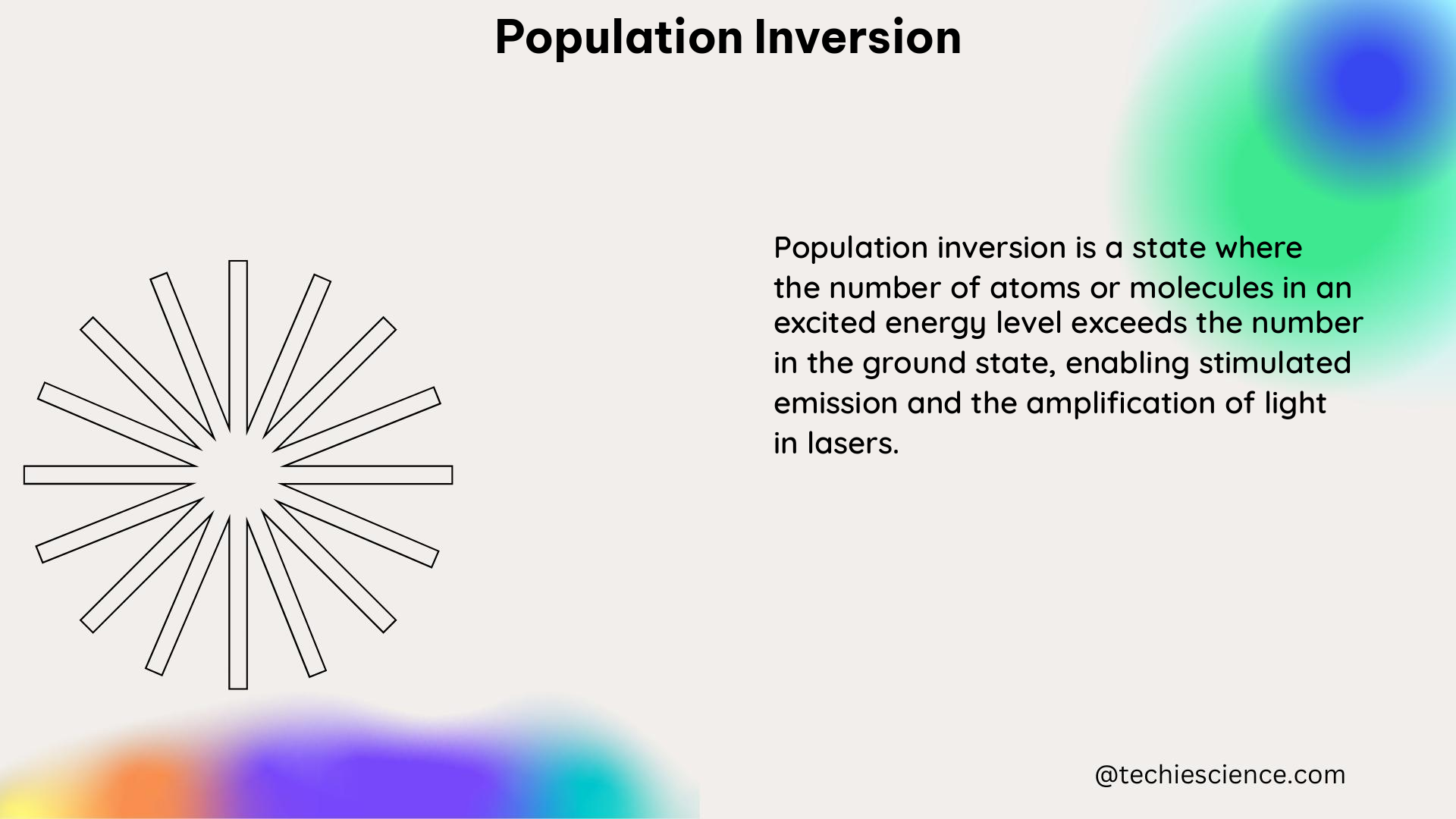Population inversion is a critical concept in laser physics, where a system has more members in a higher energy state than in a lower energy state. This inversion is necessary for laser operation, but achieving it is challenging due to the tendency of systems to reach thermal equilibrium. In this comprehensive guide, we will delve into the intricacies of population inversion, providing a detailed and technical exploration of the topic.
Understanding the Boltzmann Distribution
The Boltzmann distribution is a fundamental principle that governs the distribution of particles in a system at thermal equilibrium. It relates the population of each energy state to the energy difference between the states, the temperature, and the degeneracies of the states.
The Boltzmann distribution is expressed mathematically as:
N2/N1 = (g2/g1) * exp(-ΔE/kT)
Where:
– N2 is the population of the higher energy state
– N1 is the population of the lower energy state
– g2 is the degeneracy of the higher energy state
– g1 is the degeneracy of the lower energy state
– ΔE is the energy difference between the two states
– k is the Boltzmann constant
– T is the absolute temperature
At room temperature (T ≈ 300 K) and for an energy difference corresponding to visible light (ΔE ≈ 2.07 eV), the population of the excited state is vanishingly small (N2/N1 ≈ 0), making population inversion impossible in thermal equilibrium.
Achieving Population Inversion

To create a population inversion, we need to excite a majority of atoms or molecules into a metastable state, where they cannot emit photons spontaneously. This metastable state is often referred to as the upper laser level, and it has a longer lifetime than other excited states, allowing for a population inversion to be maintained.
One method to achieve population inversion is through optical pumping. In this process, a light source excites atoms or molecules from the ground state to the metastable state. The efficiency of this process depends on the absorption cross-section of the atoms or molecules and the intensity of the light source.
For example, in a helium-neon laser, an electrical discharge excites helium atoms to a metastable state, which then transfer their energy to neon atoms, promoting them to the metastable state and creating a population inversion.
Quantifying Population Inversion
To quantify the efficiency of population inversion, we can use the concept of optical gain. Optical gain measures the amplification of light as it passes through a medium and is proportional to the difference in population between the metastable state and the ground state (N2 – N1).
The optical gain is expressed in decibels per meter (dB/m) as:
Gain (dB/m) = 10 * log10[(N2 – N1)/N1]
For a population inversion to occur, the gain must be positive (N2 > N1). The threshold gain (Gth) is the minimum gain required for laser operation, and it is typically around 1% to 10%.
Examples and Applications of Population Inversion
Population inversion is a crucial concept in the operation of various types of lasers, including:
-
Helium-Neon Laser: In this laser, an electrical discharge excites helium atoms to a metastable state, which then transfer their energy to neon atoms, promoting them to the metastable state and creating a population inversion.
-
Ruby Laser: In a ruby laser, the active medium is a synthetic ruby crystal (chromium-doped aluminum oxide). Optical pumping with a high-intensity light source, such as a xenon flash lamp, excites the chromium ions in the crystal to a metastable state, creating a population inversion.
-
Semiconductor Lasers: In semiconductor lasers, population inversion is achieved by injecting an electric current into a semiconductor material, which promotes electrons from the valence band to the conduction band, creating a population inversion between the two bands.
-
Erbium-Doped Fiber Amplifiers (EDFAs): EDFAs are used in optical communication systems to amplify optical signals. Population inversion is achieved by optically pumping the erbium-doped fiber, which promotes erbium ions to a metastable state, creating a population inversion.
Numerical Problems and Calculations
To further illustrate the concepts of population inversion, let’s consider a numerical example:
Suppose we have a laser system with the following parameters:
– Energy difference between the upper and lower laser levels: ΔE = 2.07 eV
– Temperature of the system: T = 300 K
– Degeneracy of the upper laser level: g2 = 3
– Degeneracy of the lower laser level: g1 = 1
Using the Boltzmann distribution equation, we can calculate the ratio of the population in the upper and lower laser levels:
N2/N1 = (g2/g1) * exp(-ΔE/kT)
N2/N1 = (3/1) * exp(-(2.07 eV) / (8.617 × 10^-5 eV/K * 300 K))
N2/N1 ≈ 1.65 × 10^-5
This extremely small ratio indicates that the population in the upper laser level is negligible compared to the population in the lower laser level, making it impossible to achieve population inversion in thermal equilibrium.
To create a population inversion, we would need to use a method like optical pumping to selectively excite the atoms or molecules to the upper laser level, increasing the N2 value and making the N2 – N1 difference positive, resulting in a positive optical gain.
Conclusion
Population inversion is a fundamental concept in laser physics, and understanding it is crucial for the design and operation of various types of lasers. This comprehensive guide has provided a detailed exploration of the topic, covering the Boltzmann distribution, methods for achieving population inversion, quantifying the efficiency of population inversion, and examples of practical applications.
By mastering the concepts and techniques presented in this guide, science students can develop a deep understanding of population inversion and its role in the field of laser physics.
References:
- Qualitative Description of Stimulated Emission & Population Inversion
- Optical Gain and Population Inversion in Semiconductor Lasers
- Wikipedia – Population Inversion
- Theoretical Analysis of Population Inversion in Laser Systems
- Explanation of Population Inversion in Lasers

Hi, I am Sanchari Chakraborty. I have done Master’s in Electronics.
I always like to explore new inventions in the field of Electronics.
I am an eager learner, currently invested in the field of Applied Optics and Photonics. I am also an active member of SPIE (International society for optics and photonics) and OSI(Optical Society of India). My articles are aimed at bringing quality science research topics to light in a simple yet informative way. Science has been evolving since time immemorial. So, I try my bit to tap into the evolution and present it to the readers.
Let’s connect through